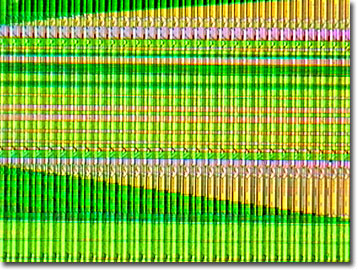Integrated Circuit Image Gallery
Pentium III Microprocessor
The Pentium III microprocessor, code named Katmai, was the next member of the P6 family to follow the Pentium II processor in the famous Intel IA-32 processor line. Released in early 1999, design engineers were able to squeeze 9.5 million transistors onto a relatively small silicon die by employing 0.25-micron, 4-layer chip fabrication technology.

View a low magnification image of the Pentium III processor.
Pentium IIIs added streaming single instruction/multiple data (SIMD) extensions (SSE) to the Intel processor repertoire in response to escalating demands for graphics-intensive applications and interfaces for the bustling personal computer market. With a 25-percent performance advantage over older Pentium IIIs operating at the same clock speed, the latest Coppermine-based (0.18-micron, 6-layer technology) Pentium IIIs had a smaller, 256-Kbyte secondary cache, but operated the memory at full chip speed on the same silicon as the core logic. The Coppermine release featured an incredible 28 million transistors packed onto a 106-square-millimeter chip with a reduction in operating voltage from 2.0 to 1.6 volts. The earlier Katmai versions were produced with clock speeds of 450, 500, 550, and 600 MHz, while a dozen redesigned Coppermine models ranged from 500 MHz to 1.2 GHz (which uses 0.13-micron technology). Each processor features 32-bit register widths, 64-bit data buses, 16-Kbyte instruction and data caches, and a 256-Kbyte (or 512-Kbyte on older models) second-level memory cache on board.
Xeon is the name Intel engineers gave to earlier Pentium IIs coupled with larger on-board internal caches, slot 2 packaging, and wider multiprocessor support. Code-named Tanner, the Pentium III Xeon was a basic update to the Pentium II version with the addition of a large secondary cache and streaming SIMD extensions, and was offered with initial clock speeds of 500 and 550 MHz. When the new Coppermine 0.18-micron technology was introduced in October 1999, Intel released three new Pentium III Xeon models with clock speed ratings up to 733 MHz. Following these, another upgrade increased clock speeds into the range of 1.8 to 2.2 GHz. Except for the outer packaging, these newer Xeons perform in much the same manner as comparable Pentium IIIs. Each Xeon is capable of supporting up to eight processors per system and features, at minimum, the full processor-speed 256-kilobyte secondary cache using Intel's wide-bus (128 Kbytes) advanced transfer cache technology. Newer editions replaced that secondary cache with 512 kilobytes (up to an optional 2 Mbytes) and feature up to 3.2-Gbyte throughputs of input/output bandwidth.
Contributing Authors
Omar Alvarado, Thomas J. Fellers and Michael W. Davidson - National High Magnetic Field Laboratory, 1800 East Paul Dirac Dr., The Florida State University, Tallahassee, Florida, 32310.
BACK TO THE INTEGRATED CIRCUIT IMAGE GALLERY
BACK TO THE DIGITAL IMAGE GALLERIES
Questions or comments? Send us an email.
© 1995-2025 by Michael W. Davidson and The Florida State University. All Rights Reserved. No images, graphics, software, scripts, or applets may be reproduced or used in any manner without permission from the copyright holders. Use of this website means you agree to all of the Legal Terms and Conditions set forth by the owners.
This website is maintained by our
Graphics & Web Programming Team
in collaboration with Optical Microscopy at the
National High Magnetic Field Laboratory.
Last Modification Friday, Nov 13, 2015 at 01:19 PM
Access Count Since September 17, 2002: 9261
Visit the website of our partner in introductory microscopy education:
|
|
